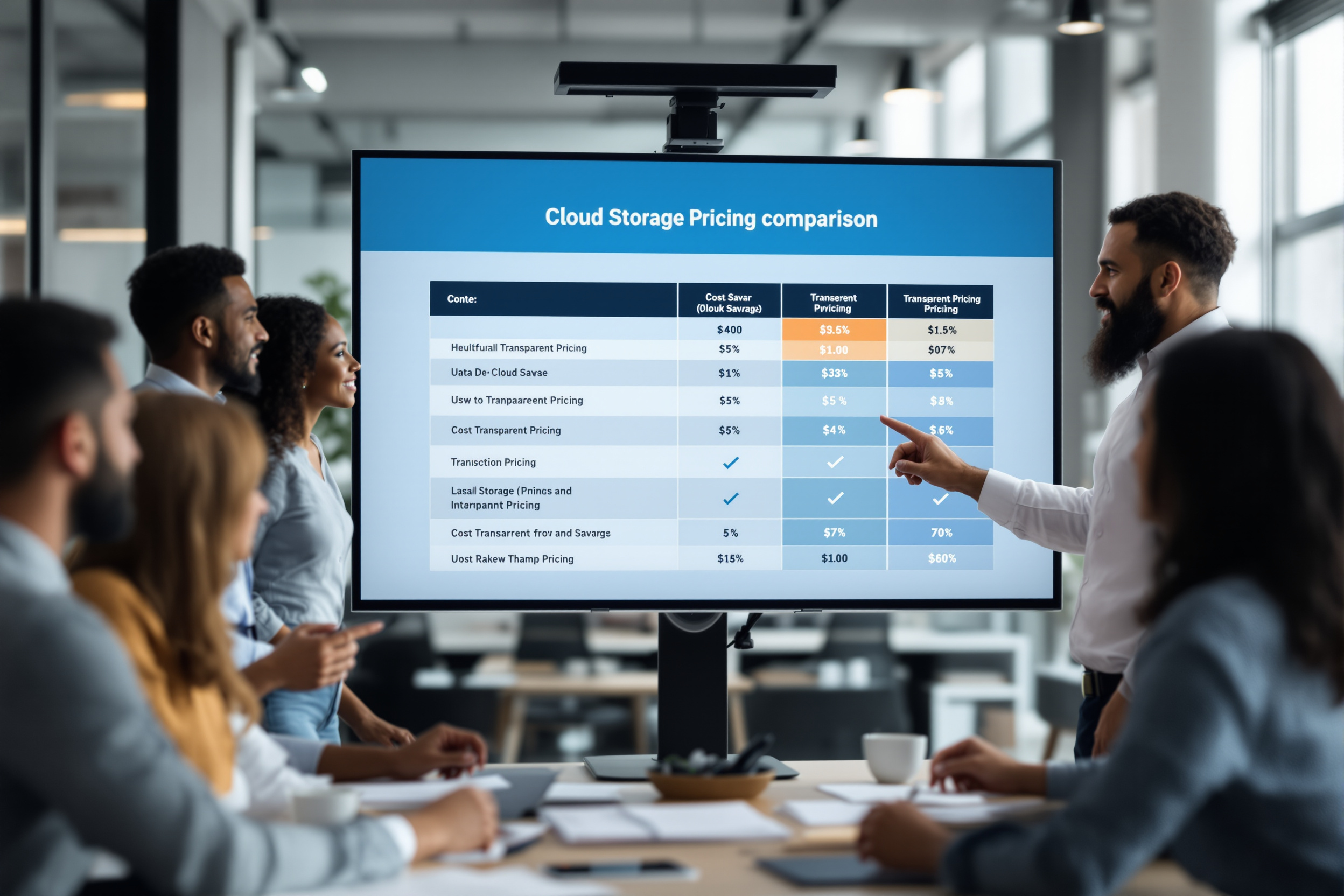Topics on this page
For IT leaders, cost unpredictability has become the number one cloud pain point. A 2025 survey revealed 95% of organizations experience unexpected cloud storage charges from major providers. These hidden costs, driven by egress fees, API calls, and complex tiers, disrupt budgets and create strategic risks. Vendor lock-in, amplified by punitive data transfer fees, makes switching providers prohibitively expensive for 55% of companies. This guide outlines a clear path to adopting cloud storage with no hidden costs, enabling data control, predictable margins, and a built-in exit strategy.
Key Takeaways
- Adopt a transparent pricing model with zero egress fees, no API call costs, and no minimum storage duration to eliminate 60-80% of typical cloud storage expenses.
- Leverage immutable storage with an "Always-Hot" access model to create a ransomware-proof backup environment that ensures immediate data availability without retrieval delays or fees.
- Utilize fully S3-compatible object storage to avoid vendor lock-in, ensuring existing tools and applications work without modification while building a practical exit strategy into your architecture.
Escape Budget Volatility with a Transparent Cost Model
Traditional cloud storage pricing is notoriously complex, leading to budget overruns for 62% of organizations. A transparent model provides cloud storage with no hidden costs by design. This approach eliminates the primary sources of financial surprises that erode IT budgets.
Key features of this predictable economic model include:
- Zero Egress Fees: You are not charged for moving your data out of the cloud, which removes the single biggest barrier to switching providers for 55% of IT leaders.
- No API Call Costs: Frequent data operations, common in backup and analytics, do not generate extra charges, which can otherwise inflate bills by 3-5x.
- No Minimum Storage Duration: You only pay for what you use, for as long as you use it, increasing storage efficiency by at least 15%.
This streamlined model can eliminate 60-80% of typical cloud storage expenses. It transforms cloud storage from a volatile operational expense into a predictable, manageable line item. This financial stability is the foundation for building a more resilient and agile IT strategy.
Strengthen Ransomware Defense with Immutable, Always-Hot Storage
Ransomware attacks increasingly target backup infrastructure, making immutable storage a non-negotiable security layer. Immutability, or Object Lock, ensures that once data is written, it cannot be altered or deleted for a defined period. This creates a secure copy that is impervious to encryption by malicious actors, guaranteeing a clean recovery point.
An "Always-Hot" storage model complements this security by ensuring all data is immediately accessible. Unlike tiered models that can delay restores by hours, this approach provides instant access to any file, which is critical during a recovery event. This architecture eliminates retrieval fees and performance bottlenecks, reducing recovery times by up to 50%.
This combination delivers up to 20% faster backup performance compared to traditional cloud storage. It provides a resilient defense against threats while simplifying operations. With enterprise-grade compliance certifications like SOC 2 and ISO 27001, you can secure regulated workloads without vendor lock-in. This integrated approach is essential for modern data protection.
Maintain Full Control with Seamless S3 Compatibility
Vendor lock-in is a top concern for IT leaders, creating strategic risks and limiting flexibility. An S3-compatible alternative provides a direct path to data independence. Full S3 API compatibility ensures your existing applications, scripts, and backup tools continue to work without code rewrites, protecting past investments and reducing migration risk by over 50%.
A true drop-in replacement goes beyond basic operations. It supports advanced capabilities consistently across the API, CLI, and SDK, including:
- Versioning for granular object history.
- Lifecycle management to automate data policies.
- Event notifications for workflow automation.
- Object tagging for granular cost allocation and access control.
This level of compatibility allows you to switch endpoints in minutes, not months. By pairing a standard API with a model free of egress fees, you build an exit strategy directly into your architecture. This preserves your long-term freedom of action and negotiating power.
Enable Partner Profitability with Predictable Margins
For Managed Service Providers (MSPs), profitability depends on predictable recurring revenue, yet 80% exceed their cloud budgets due to hidden fees. A predictable storage model is designed for the channel. Eliminating egress and API fees allows MSPs to quote BaaS and DRaaS services with confidence, knowing their margins are protected from surprise charges.
This partner-ready approach delivers tangible advantages. Recovering just 10TB of data from a hyperscaler can generate over $900 in egress fees, erasing a month's profit. With a transparent model, that cost disappears. MSPs can increase profitability on existing contracts or pass savings to customers for a competitive advantage of 10-15%.
A multi-tenant partner console with robust IAM, MFA, and RBAC simplifies management and security. Automation via the API and CLI, combined with clear reporting, accelerates onboarding and reduces operational overhead by up to 30%. This makes it easier to deliver more affordable cloud storage and build sustainable, high-margin services.
Execute a Practical, Low-Risk Migration
Migrating to a new storage provider should accelerate value, not create complexity. With an S3-compatible platform, the process is straightforward and low-risk. Since the API is identical, no application refactoring is needed, which typically accounts for over 40% of migration project costs. The focus shifts from technical hurdles to a simple, policy-driven data transfer.
A successful migration can be completed in four steps:
- Configure Credentials: Create new IAM users and access keys in the new environment, ensuring permissions align with your security policies.
- Update Endpoint: Change the S3 endpoint URL in your backup software, scripts, or applications to point to the new provider.
- Sync Data: Use your existing tools or a data mover to sync your data buckets to the new storage platform.
- Test and Validate: Perform test restores to verify data integrity and confirm that your recovery time objectives (RTOs) are met.
Because there are no egress fees, you can perform extensive validation without financial penalties. This ensures a seamless transition to a more predictable and cost-efficient storage solution, setting the stage for long-term savings and operational stability.
More Links
GM Insights offers an industry analysis of the cloud storage services market.
Fortune Business Insights provides insights into the cloud computing market in Germany.
Statista offers statistics and data related to cloud computing.
Statistisches Bundesamt (Destatis) presents tables and data on the use of cloud computing within German companies, focusing on ICT in enterprises.
Bundesministerium für Wirtschaft und Klimaschutz (BMWK) discusses the status and development of Germany as a data center location.
Bitkom reports on the German economy's call for a domestic cloud solution.
FAQ
How can I start migrating to a cloud storage provider with no hidden costs?
Migration to an S3-compatible platform is straightforward. First, set up your new account and security credentials. Next, update the S3 endpoint in your existing backup software or application. Finally, sync your data and conduct test restores to validate the setup. The entire process requires no code changes.
Is this type of storage suitable for enterprise workloads?
Yes. It is designed for enterprise use cases like backup, disaster recovery, and archiving. It includes essential enterprise features like multi-layer encryption, IAM with MFA/RBAC, and immutable storage. It also holds key compliance certifications, including SOC 2 and ISO 27001.
Can I use my existing backup tools like Veeam or NovaBackup?
Absolutely. Full S3 API compatibility ensures out-of-the-box integration with leading backup and data management tools, including Veeam and NovaBackup. You can continue using your current workflows while benefiting from a more predictable cost structure.
How does a no-egress-fee model benefit MSPs?
For MSPs, eliminating egress fees removes a major source of unpredictable costs. This allows you to price your backup and disaster recovery services with confidence, protecting your margins. It also means you won't be penalized for performing restores or migration tests for your clients.
What does 'Always-Hot' storage mean?
'Always-Hot' means all your data is stored in a single, high-performance tier that is always online and instantly accessible. This eliminates the complexity, delays, and retrieval fees associated with moving data between hot and cold storage tiers, which is especially important for fast disaster recovery.
How do I calculate my potential savings?
To calculate your savings, analyze your current cloud bills, focusing on charges for data egress, API requests, and any fees related to storage tiering or minimum duration. A provider with a transparent model eliminates these charges, often resulting in 60-80% total cost savings. Contact us for a personalized TCO analysis.



.png)
.png)
.png)
.png)



.png)



%201.png)